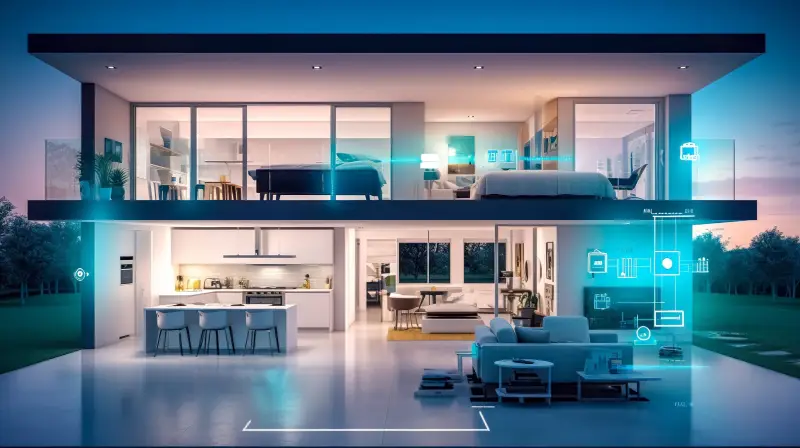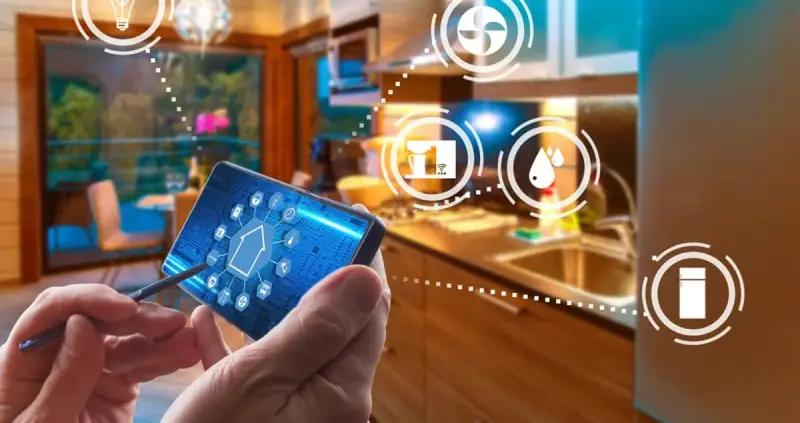Como produto da profunda integração da tecnologia moderna e da vida, as principais características de Casas inteligentes são refletidos principalmente na inteligência, networking, automação, conveniência, conforto, e segurança. Esses recursos juntos formam a base de sistemas domésticos inteligentes, Fornecendo aos usuários experiências de vida sem precedentes. A seguir, é apresentada uma explicação detalhada das principais características das casas inteligentes.
Inteligência

A inteligência é uma das características mais proeminentes das casas inteligentes. Isso se reflete na capacidade do sistema de melhorar continuamente o desempenho e a eficiência através do aprendizado e auto-aperfeiçoamento, Assim, melhor atender às necessidades dos usuários. Os recursos inteligentes incluem os seguintes aspectos:
- Capacidade de auto -aprendizado: Os sistemas domésticos inteligentes podem ajustar e otimizar automaticamente o status operacional dos dispositivos analisando usuários’ hábitos de uso e padrões de comportamento. Por exemplo, Um sistema inteligente de controle de temperatura pode ajustar automaticamente a temperatura interna com base nas preferências do usuário e nas mudanças no ambiente externo para manter o conforto ideal.
- Capacidade de tomada de decisão inteligente: O sistema é capaz de tomar decisões inteligentes e executar operações correspondentes com base em condições predefinidas ou dados em tempo real. Por exemplo, Os sistemas de segurança inteligentes podem acionar automaticamente alarmes e notificar os usuários ou departamentos relevantes quando o comportamento anormal é detectado.
- Capacidade de controle remoto: Os usuários podem controlar remotamente seus dispositivos inteligentes em casa através de aplicativos móveis, Plataformas da Web, etc., alcançando gerenciamento conveniente a qualquer hora, em qualquer lugar. Esta função de controle remoto não apenas melhora a conveniência da vida, mas também aprimora a segurança da casa.
Networking

A rede é a base para alcançar inteligência e automação em casas inteligentes. Refere -se à capacidade de dispositivos e sensores em sistemas domésticos inteligentes de comunicar e trocar dados entre si, formando um ambiente de rede inteligente. Os recursos de rede incluem os seguintes aspectos:
- Interconexão do dispositivo: Vários dispositivos em sistemas domésticos inteligentes, como lâmpadas inteligentes, soquetes inteligentes, câmeras inteligentes, etc., pode ser conectado um ao outro por meio de redes sem fio ou com fio para obter compartilhamento de informações e trabalho colaborativo.
- Compartilhamento de dados: O sistema pode coletar e processar dados de vários dispositivos, como parâmetros ambientais, como temperatura, umidade, e intensidade da luz, bem como registros de operação do usuário e hábitos comportamentais. Esses dados são armazenados e analisados através de plataformas de nuvem, fornecendo forte apoio à tomada de decisão inteligente.
- Suporte da plataforma: Os sistemas domésticos inteligentes geralmente exigem uma plataforma unificada para gerenciar e controlar vários dispositivos. Esta plataforma pode ser um aplicativo móvel, Plataforma da Web, ou assistente de voz, etc.. Os usuários podem controlar e gerenciar facilmente seus dispositivos inteligentes em casa através dessas plataformas.
Automação

Automação é um meio importante para as casas inteligentes melhorarem a conveniência da vida. Refere-se ao sistema capaz de executar automaticamente as operações correspondentes com base em condições predefinidas ou dados em tempo real, sem a necessidade de intervenção manual do usuário. Os recursos de automação incluem os seguintes aspectos:
- Modo de cena: O sistema doméstico inteligente pode definir vários modos de cena (como o modo doméstico, modo doméstico, Modo de observação de filmes, etc.) De acordo com as necessidades do usuário, e ajuste automaticamente o status de operação do dispositivo no modo correspondente. Por exemplo, no modo de distância do lar, O sistema desligará automaticamente as luzes, ar condicionado, e outros dispositivos em casa, e ativar o sistema de segurança; No modo doméstico, As luzes e a música vão acender automaticamente.
- Tarefas programadas: Os usuários podem definir tarefas agendadas para executar automaticamente determinadas operações. Por exemplo, Máquinas de lavagem inteligentes podem ser definidas para começar automaticamente programas de lavagem à noite para evitar períodos de uso de água e eletricidade de pico de eletricidade.
- Detecção ambiental: Os sistemas domésticos inteligentes também podem sentir mudanças no meio ambiente através de vários sensores e ajustar automaticamente o status operacional do dispositivo para se adaptar ao ambiente. Por exemplo, Cortinas inteligentes podem abrir e fechar automaticamente de acordo com a intensidade da luz para ajustar a iluminação interna; O sistema inteligente de controle de temperatura pode ajustar automaticamente o status de funcionamento do ar condicionado ou aquecimento de acordo com a temperatura interna.
Conveniência

A conveniência é um dos principais fatores para melhorar a experiência do usuário em sistemas domésticos inteligentes. Isso se reflete na capacidade do sistema de simplificar o processo de operação do usuário e reduzir a carga operacional do usuário. Os recursos de conveniência incluem os seguintes aspectos:
- Operação de um clique: Os sistemas domésticos inteligentes geralmente fornecem funções de operação de um clique para simplificar o processo de operação do usuário. Por exemplo, Os usuários podem controlar simultaneamente vários dispositivos em sua casa (como desligar todas as luzes e aparelhos) com um botão ou uma frase.
- Controle de voz: Com o desenvolvimento contínuo da tecnologia de reconhecimento de voz, Os sistemas domésticos inteligentes agora podem alcançar funções de controle de voz. Os usuários podem controlar dispositivos inteligentes em casa através de comandos de voz, Sem a necessidade de operação manual ou busca de dispositivos de controle, como controladores remotos.
- Lembrete inteligente: Os sistemas domésticos inteligentes também podem fornecer serviços de lembrete inteligentes com base em usuários’ necessidades e hábitos. Por exemplo, Enviando mensagens de lembrete aos usuários quando eles esquecem de desligar ou fechar as portas; Forneça listas de compras e sugestões quando os usuários precisam comprar necessidades diárias.
Conforto e SHafety

Conforto e segurança são objetivos importantes dos sistemas domésticos inteligentes. Eles se refletem na capacidade do sistema de fornecer aos usuários um ambiente de vida mais confortável e seguro. Os recursos de conforto e segurança incluem os seguintes aspectos:
- Regulamentação ambiental: Sistemas domésticos inteligentes podem monitorar e ajustar parâmetros ambientais internos (como temperatura, umidade, intensidade da luz, etc.) Através de vários sensores e dispositivos inteligentes para fornecer um ambiente de vida mais confortável. Por exemplo, Um sistema inteligente de controle de temperatura pode ajustar automaticamente o status de funcionamento do ar condicionado ou aquecimento de acordo com a temperatura interna para manter uma temperatura interna constante; O sistema de iluminação inteligente pode ajustar automaticamente o brilho das luzes de acordo com a intensidade da luz para fornecer um ambiente de iluminação adequado.
- Proteção de segurança: Os sistemas domésticos inteligentes podem melhorar a segurança das casas instalando dispositivos como fechaduras de portas inteligentes e câmeras inteligentes. Esses dispositivos podem monitorar o status de segurança das famílias em tempo real e enviar informações de alerta para usuários ou departamentos relevantes; Ao mesmo tempo, Tecnologias como o reconhecimento facial podem ser usadas para impedir que estranhos invadissem a casa.
- Monitoramento da saúde: Alguns sistemas domésticos inteligentes também têm funções de monitoramento de saúde, como colchões inteligentes que podem monitorar usuários’ qualidade do sono e fornecer conselhos de saúde; A escala de peso inteligente pode registrar as alterações de peso do usuário e avaliar seu estado de saúde. Esses recursos ajudam os usuários a entender melhor sua condição física e tomar medidas apropriadas para manter sua saúde.
SUmmary
Resumindo, As principais características das casas inteligentes incluem inteligência, networking, automação, conveniência, conforto, e segurança. Esses recursos são inter -relacionados e reforçando mutuamente, Juntos, formando uma solução inteligente de sistema doméstico.
